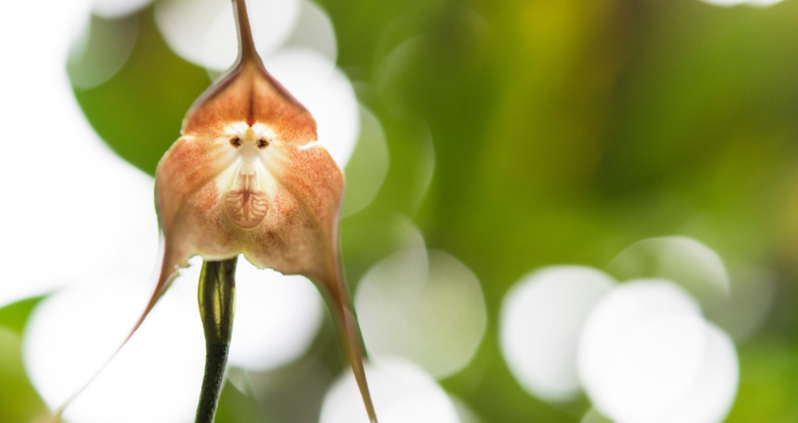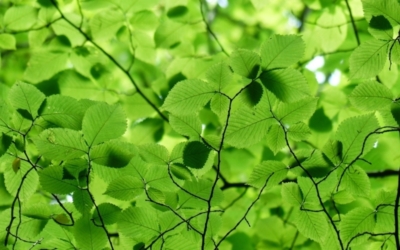Ghoulish Garden: Six of the World’s Creepiest Flowers
The word “flower” usually evokes something beautiful and fragrant – maybe a classic rose, a bright peony or a stately lily. But like most of nature, flowers run the gamut from ordinary to unusual — and sometimes, they can be downright frightening. But just because they’re not dainty or sweet-smelling doesn’t mean these plants are not worth learning about.
With Halloween approaching, it’s the perfect time to explore the creepier parts of the natural world. Take a look at these six lesser-known flowers from across the globe that are spooky enough to rival any Halloween decorations.
Corpse flower (Amorphophallus titanum)
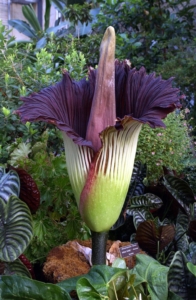 Native to the rainforests of Sumatra, the corpse flower draws its name from the odor of rotting flesh it produces while blooming. The flower’s inflorescence, or main cluster of flowers, can grow to be over 10 feet tall, making it the largest unbranched inflorescence in the world. It doesn’t bloom often, taking anywhere from four to ten years to flower, and when it does, it usually only blooms for one or two days.
Native to the rainforests of Sumatra, the corpse flower draws its name from the odor of rotting flesh it produces while blooming. The flower’s inflorescence, or main cluster of flowers, can grow to be over 10 feet tall, making it the largest unbranched inflorescence in the world. It doesn’t bloom often, taking anywhere from four to ten years to flower, and when it does, it usually only blooms for one or two days.
The putrid scent of this flower attracts insects like flesh flies and carrion beetles, which aid in pollination. The corpse flower also grows brightly colored, round fruits that are poisonous to humans. However, they do serve as food for the rhinoceros hornbill, which then helps disperse the seeds.
The International Union for Conversation of Nature has listed the corpse flower as endangered and estimates that there are fewer than 1,000 growing in the wild. Deforestation and conversion of land to plantations are two of the leading causes of the corpse flower’s decline.
Flor de Muerto (Lisianthus nigrescens)
 This flower’s name translates to “Flower of Death,” and it is considered the blackest naturally occurring flower in the world. This perennial is native to Mexico and Guatemala, and it’s named not only for its black petals but also for the cultural practice of planting it around graves.
This flower’s name translates to “Flower of Death,” and it is considered the blackest naturally occurring flower in the world. This perennial is native to Mexico and Guatemala, and it’s named not only for its black petals but also for the cultural practice of planting it around graves.
Flor de muerto has long, bell-shaped flowers that droop from the stems, looking almost like they are wilted or dead. The flower’s unusual coloration presents an eerie mystery: Since black absorbs ultraviolet and visible light, and the flowers have no odor when blooming, scientists are unsure how flor de muerto is able to attract pollinators.
Monkey face orchid (Dracula simia)
When looking at a flower, no one expects a face to look back — but with this species, commonly referred to as a monkey face orchid, that’s exactly what happens. The center of the flower so strongly resembles a monkey’s face that it’s difficult to see it as anything else. There are more than 100 varieties of this orchid, and some even appear to be grinning menacingly. Its shape may be the result of mimicry, as the dracula genus evolved to resemble mushrooms in order to attract fruit flies that often frequent fungi.
These plants are epiphytes, which means they grow on the surface of trees and obtain moisture and nutrients from the organic matter surrounding them. Although rare, monkey face orchids are found naturally in the cloud forests of Peru and Ecuador, where they bloom throughout the year at elevations around 3,000 – 6,000 feet. Unlike some of the other flowers on this list, dracula simia has a pleasant fragrance of ripe oranges, so while its appearance may be off-putting, its scent is anything but.
Black bat flower (Tacca chantrieri)
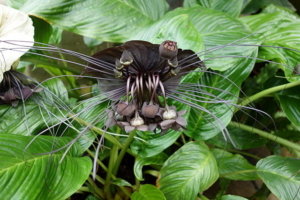 Another flower that is reminiscent of an animal, the black bat flower’s bracts resemble large wings, with whisker-like filaments that can grow up to 28 inches long. Native to southeast Asia, this plant is related to the yam and has been traditionally used for food and medicine, although its bitter flavor may be an acquired taste. Due to the effects of climate change on its tropical ecosystem, the black bat flower is considered endangered.
Another flower that is reminiscent of an animal, the black bat flower’s bracts resemble large wings, with whisker-like filaments that can grow up to 28 inches long. Native to southeast Asia, this plant is related to the yam and has been traditionally used for food and medicine, although its bitter flavor may be an acquired taste. Due to the effects of climate change on its tropical ecosystem, the black bat flower is considered endangered.
Like the corpse plant, the black bat flower also has the unmistakable smell of rotting flesh, thought to be a way to attract carrion flies. Over the years, spooky folklore has attached itself to this flower — specifically that staring at it too long will result in being stalked by the evil eye. However, with a plant this intriguing and unique-looking, it’s hard not to stare!
White baneberry (Actaea pachypoda)
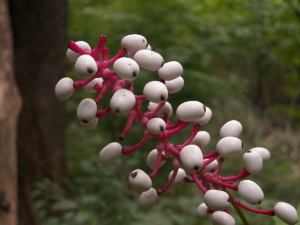 Also known as doll’s eyes, this plant features clusters of round, white fruits with a small black spot that closely resemble tiny human eyeballs. As if their creepy appearance wasn’t enough to discourage people from disturbing them, these berries are also extremely poisonous to humans and can even blister the skin if touched. However, several bird species, including the ruffed grouse and American robin, can eat baneberry fruit without any adverse effects, so they help to disperse the plant’s seeds. A member of the buttercup family, white baneberry is native to eastern North America, including parts of Canada and the United States.
Also known as doll’s eyes, this plant features clusters of round, white fruits with a small black spot that closely resemble tiny human eyeballs. As if their creepy appearance wasn’t enough to discourage people from disturbing them, these berries are also extremely poisonous to humans and can even blister the skin if touched. However, several bird species, including the ruffed grouse and American robin, can eat baneberry fruit without any adverse effects, so they help to disperse the plant’s seeds. A member of the buttercup family, white baneberry is native to eastern North America, including parts of Canada and the United States.
Stinking corpse lily (Rafflesia arnoldii)
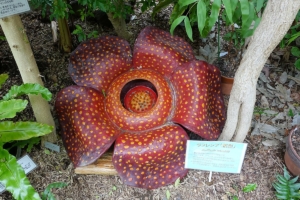 This giant parasitic flower produces the largest individual flower in the world, which can grow to be one meter in diameter and weigh about 10 kilograms (approximately 22 pounds). They are native to the rainforests of Sumatra and Indonesia, where they grow inside tetrastigma vines as thin fibers before their large red-and-orange speckled lobes sprout out of the host. Even though their scent is similar to the corpse flower above, these two species are not related.
This giant parasitic flower produces the largest individual flower in the world, which can grow to be one meter in diameter and weigh about 10 kilograms (approximately 22 pounds). They are native to the rainforests of Sumatra and Indonesia, where they grow inside tetrastigma vines as thin fibers before their large red-and-orange speckled lobes sprout out of the host. Even though their scent is similar to the corpse flower above, these two species are not related.
Through DNA testing, biologists discovered that at least one species of rafflesia no longer has a chloroplast gene, which is typically used by plants for cellular processes like making food. It would appear that this parasitic plant was able to shed genes that were no longer useful to it in favor of picking up elements from its host’s DNA — perhaps making them the mad scientist of the plant kingdom.
While these flowers may not be ones you’d see in a typical garden, they represent just a fraction of the sheer diversity of plant life on earth. They may be a little bit creepy — but they’re also fascinating examples of biodiversity, resilience and evolutionary change.
